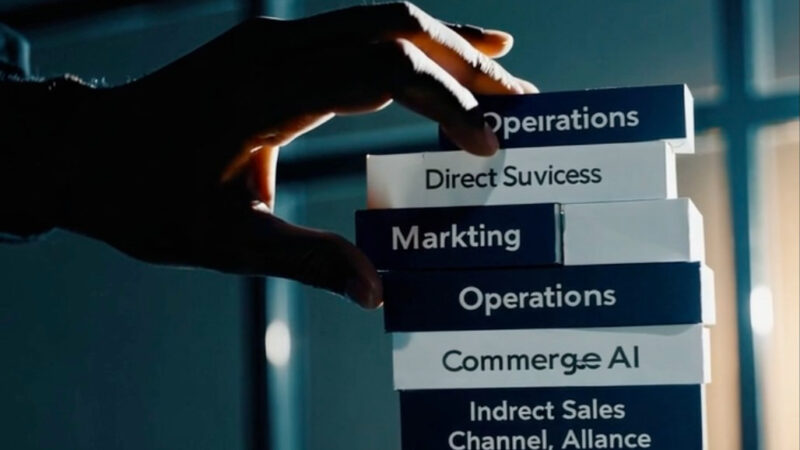Direct Sales at an AI Company
Direct Sales of AI Automation Solutions (The Wins)
I had committed to 5 years, and even though I didn’t envision it taking as long as it did, we finally achieved most of what we originally set out to accomplish back in October 2019. For example, as I exited Conversica in Q2 2025, the team celebrated reaching 90% of quota in Q1 2025, following an 80% achievement in Q4 2024, reinforcing that this wasn’t a one-off—but a sustainable upward trend (with maintained investment). In a challenging macro environment where many AI companies are struggling to hit their numbers, Conversica’s Direct Sales team delivered standout performance.
This performance reflected the culmination of a deliberate five-year evolution across nearly every go-to-market model. We transitioned from an inside sales model focused exclusively on SMB, to a mid-market and enterprise field sales team. From channel-led to enterprise ABM, from hands-on enterprise selling to one where we added PLG with self-serviced trials, Conversica tested, refined, and evolved. What we were executing when I left was the most optimized version of that GTM playbook—horizontally applicable, vertically focused, value-driven, and outcome-anchored.
The sales team was strategically concentrated on three verticals: automotive (a legacy strength), technology (with scalable AI demand), and entertainment focused on sports (where automation drives high engagement). In each, the team targeted the most critical, revenue-generating use cases, always tying each one directly to ROI based on past experience with existing customers. This reflected the fact that Conversica had shifted from selling features in 2019 to selling outcomes in 2025, winning over even the most budget-conscious enterprise buyers.
While peers are lowering targets and resetting expectations, Conversica’s Direct Sales function was proving that a mature, focused GTM strategy—anchored in customer value and strategic execution—could deliver consistent, high-quality performance.
Direct Sales – Strategic Headwinds (The Losses)
Over the course of my five-year tenure at Conversica, we not only evolved and optimized our Direct Sales strategy—we did so with a clear-eyed view of the structural headwinds we knew would challenge us. These weren’t blind spots; they were anticipated friction points that required constant adaptation as we pioneered a new category in AI automation. Translation – you can’t “set it and forget it”. This business required constant change, almost every quarter, to address a fast-moving buyer and AI ecosystem.
1. The SDR-Led Model Was Fundamentally Flawed for Enterprise AI
Before I arrived in 2019, Conversica had heavily invested in an SDR-led pipeline generation model. But as enterprise buying behavior evolved, this motion quickly lost its effectiveness. Ironically, we weren’t using our own AI automation for inbound or outbound, a gap we closed immediately. We later made the bold decision to even sunset the entire Conversica human SDR team, replacing them with Conversica’s own AI (why not drink our own Champagne!?), and shifted responsibility for inbound pipeline fielding and outbound pipeline generation directly to AEs, using our automation platform. However, even with pairing human reps with AI, it became evident that top-down, use-case-driven engagement was far more impactful than any traditional SDR campaign—regardless of whether it was human or machine or a combination. AI SDR automation can work well for SMB, but becomes much more complex as you move up-market. We were executing some of the most complex AI campaigns, using ABM to warm up leads, and different AI for various levels of buyers, with everything personalized for industry, product/service, buyer persona, etc.
2. Horizontal GTM with a Vertical Overlay Created Execution Strain
From the beginning, our GTM strategy was horizontal by necessity—we couldn’t control who entered the funnel, no matter how hard we tried with industry-specific campaigns—but that being said, we always overlaid a vertical focus where it mattered most (aka where we saw the greatest traction). The sales team prioritized key verticals like automotive, technology, and sports/entertainment, tailoring offerings to speak directly to industry-specific pain points. While Sales was told to field 70% of their own pipeline (a requirement to even work at Conversica), we only expected them to generate 40–50% of total pipeline, with the balance coming from Marketing. We also gave them the best tool in the industry, namely, Conversica! Regardless of the target; however, their contribution often fell short. This mismatch between strategic intent and execution reality created consistent strain on capacity, diluted vertical specialization, and made it harder to fully realize the benefits of our industry focus. Why did this happen? Read on.
3. The Greatest Threat Was “Do Nothing”
Selling AI automation isn’t just about displacing a competitor—it’s about overcoming fundamental human bias. Many enterprise buyers still defaulted to human labor as their benchmark for value. Our biggest competitor wasn’t another vendor—it was inertia. 11X AI, Clay, Regie, Artisan, Qualified, all were either too small, or focused on the long-tail (e.g. SMB), or late to the game (we were the #1 in our category) resulting in us hardly seeing them. Human vs. AI was our true challenge, even when ROI was clear – the comfort of the status quo created friction. Winning required not only proof of financial value, but a reframing of work itself. It demanded that we couldn’t position our AI as a human “replacement” but rather as “augmentation.” There were some bold clients who embraced 100% AI models, successfully. but they were the exception. We had long moved from positioning Conversica as an “engagement booster” and/or “cost saver” in 2019 to a full-fledged “revenue accelerator” with clear ROI by 2025.
These challenges didn’t derail us—they sharpened us. They forced us to confront the realities of the market, refine our narrative, and build a sales organization that’s not only aligned with how enterprise AI is bought, but how it needs to be sold. The results—culminating in 80%-90% quota attainment over consecutive quarters—speak to the strength of a team that embraced, rather than avoided, the hard problems.
Sound familiar? Are you an AI company CEO and selling to mid-market and enterprise customers, globally? Have another opinion?
Advice From One CEO to Another – Navigating AI GTM in 2025
-
Your AI must deliver business outcomes—not just automation.
You’re not selling AI. You’re selling revenue lift, cost reduction, or cycle time compression. Tie your product narrative directly to metrics your buyer’s CFO tracks. -
Don’t chase the noise—build GTM muscle deliberately.
The AI tools race is loud, but maturity wins. Iterating across GTM models is expensive but necessary. Stick to a hypothesis, test it hard, and don’t be afraid to kill what doesn’t scale. -
Outcomes > Optics.
Replace “we’re innovating” with “we’re growing X% faster than industry average in Y segment.” That’s what builds investor confidence and closes enterprise deals. -
Beware the “do nothing” trap.
Your biggest competitor isn’t the AI startup next door—it’s inertia. Frame your value in terms of loss avoidance (opportunity cost) as much as gain. Drive urgency. -
Verticals win.
Generic messaging is dead. Invest in understanding up to 3 core verticals deeply—build use cases, ROI benchmarks, and customer language that resonates. It shortens cycles and increases win rates. -
Be your own best customer.
Use your own AI in the go-to-market motion. Nothing beats firsthand proof. It’s how we closed the credibility gap and created internal alignment at Conversica. -
Align Sales, Customer Success, and Marketing on one story.
Fragmented GTM teams stall deals. One clear, value-based narrative—repeated from product deck to outbound email (or AI campaigns)—builds buyer trust.
Strategy isn’t built in slides. It’s forged in hard conversations, late-night pivots, and the messy middle of execution. Every bold move we made as a company lived or died by the strength of our executive team. What follows isn’t just my perspective—it’s the collective experience of those who were in the trenches. The functional leaders who owned the inflection points. Who navigated the trials, learned from the misfires, and helped turn strategy into motion. This is what transformation really looks like—function by function, leader by leader, decision by decision.
- Executive Team Management
- Direct Sales
- Indirect Sales / Channel / Alliances
- Marketing
- Customer Success Management
- Technical / Customer Support
- Professional Services
- Product Management
- R&D
- Cloud Operations / DevSecOps
- Legal / Security / Compliance
- HR / People
- Finance
- International Operations
- Corporate Development
- Board Management



